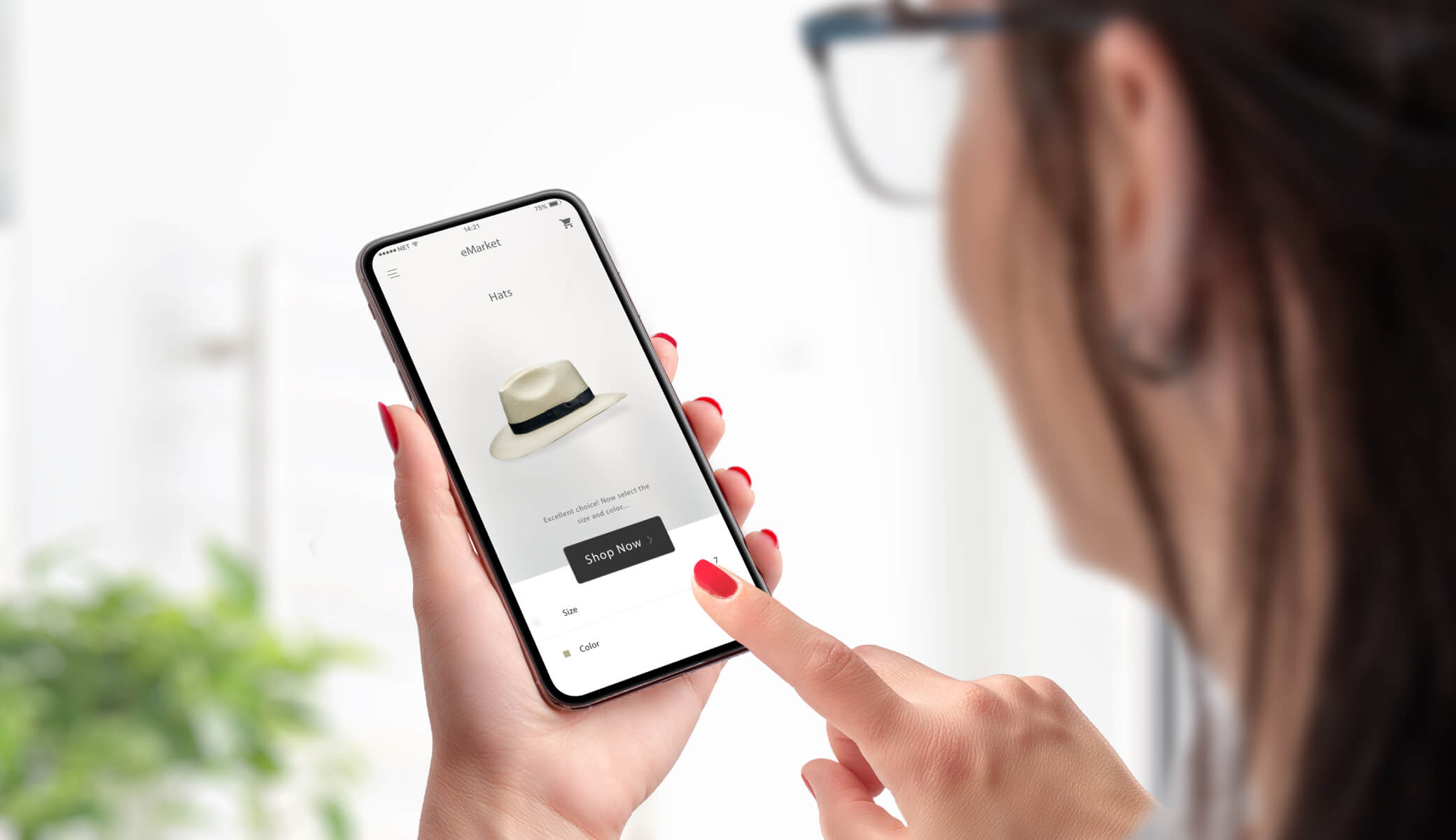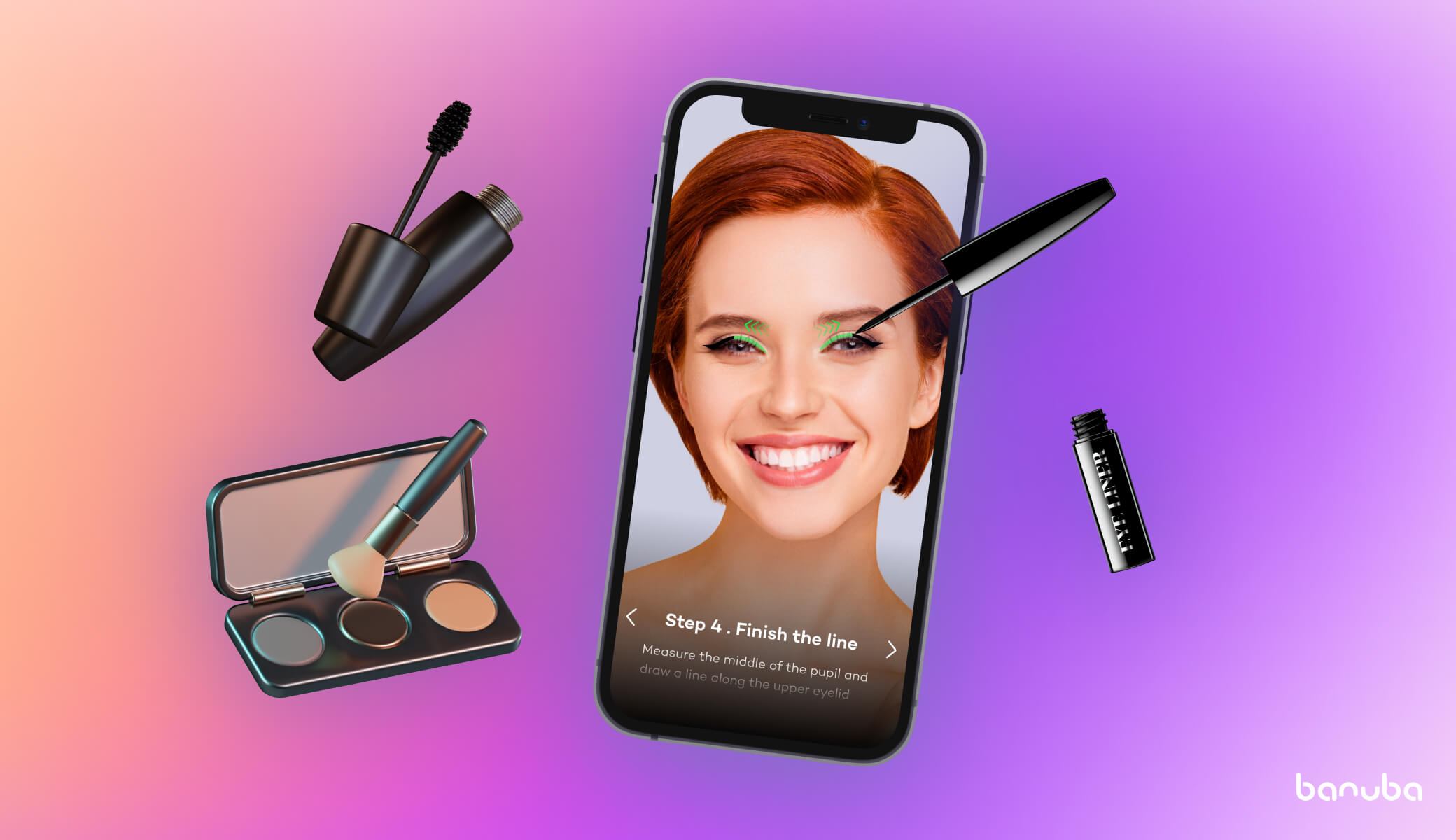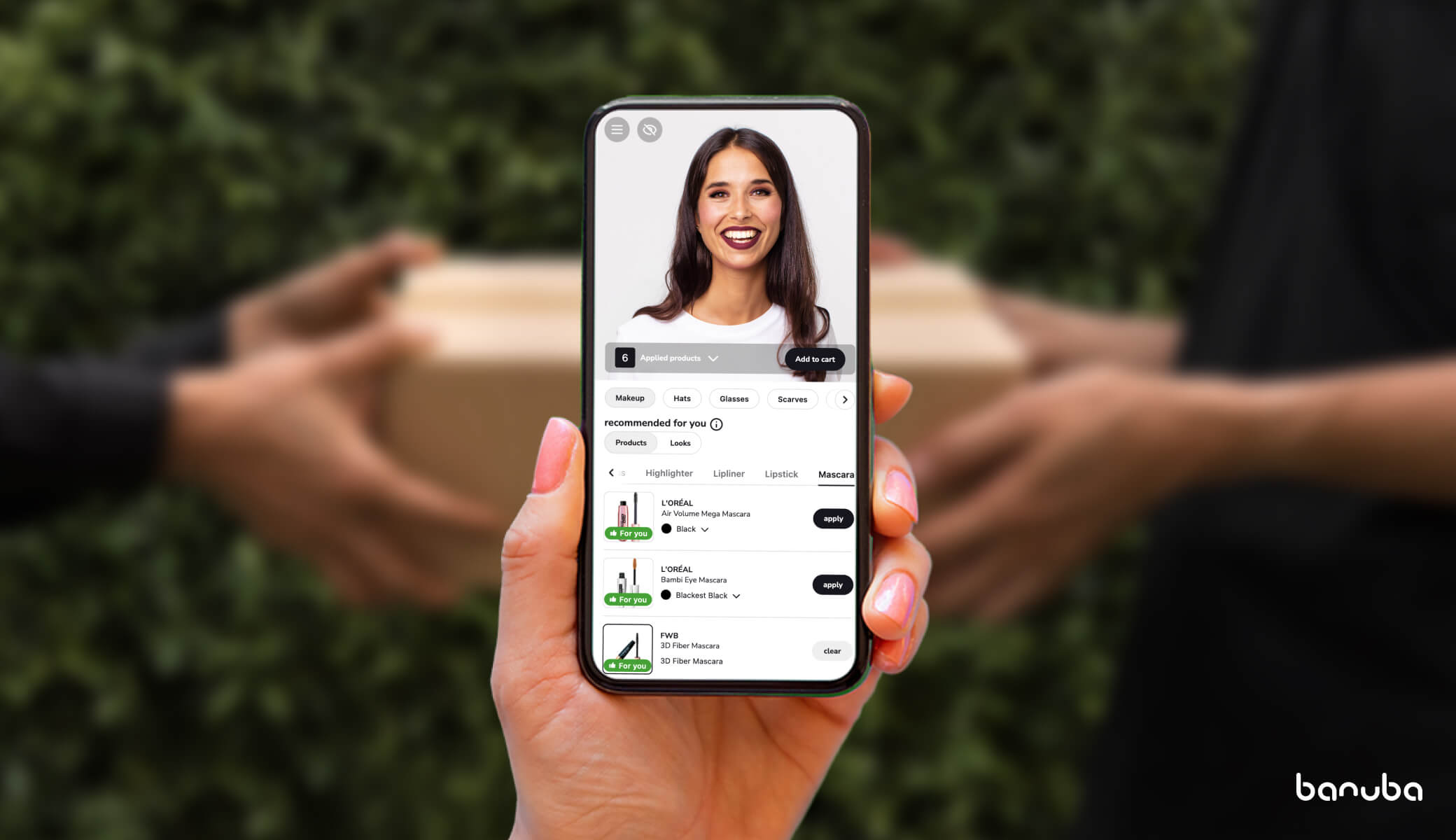Augmented Reality Marketing: Campaigns, Benefits & Best Practices
The world is overloaded with information and content, making drawing attention to your product challenging. Welcome to the new era of selling powered by augmented reality marketing, which merges the digital world with the real environment and creates immersive campaigns to seize attention.
Customers value experience over promises. Over 61% of consumers prefer brands with AR in the customer journey. At the same time, only 1% of retailers have adopted this tech-savvy approach. According to Forbes, the trend for AR marketing will double in the upcoming years.
Banuba has been producing AR solutions and enhancing innovative marketing campaigns for over 12 years now. Keep reading to explore how augmented reality has altered digital and traditional marketing, review live examples, face key challenges and solutions, and build an AR strategy.


[navigation]
What is Augmented Reality Marketing?
AR marketing overlays virtual visuals, audio, or other sensory inputs with the physical world in real time. These layers can be lifelike product models, interactive filters, or animated brand mascots appearing on any device with a camera.

AR in advertising transforms static campaigns into dynamic, two-way experiences. Rather than receiving a sales pitch, consumers become the main heroes in the marketing message. Compared to traditional marketing, this approach feels less intrusive than pop-ups or banner ads.
A Mindshare UK study found that augmented reality increases ad recall by 70%, significantly enhancing brand message retention and keeping your brand top-of-mind with audiences.
Additionally, Shopify states that the AR shopping experience boosts conversion rates by 94%. This jump arises from users spending more time engaging, exploring, and personalizing their experiences.
 It’s a golden chance for marketers and brands to stand out in a saturated ad market. Let's move to augmented reality marketing use case examples to make this article more practical and inspiring.
It’s a golden chance for marketers and brands to stand out in a saturated ad market. Let's move to augmented reality marketing use case examples to make this article more practical and inspiring.
AR Marketing Examples
- Virtual try-on to allow consumers to “wear” products like makeup, accessories, jewelry, etc. digitally, reducing uncertainty in online shopping;
- Digital product samples to promote products via virtual try-on before they hit the shelves;
- 3D product visualization to present items in photorealistic 3D, enabling customers to inspect every angle before purchasing;
- Interactive packaging to transform product boxes or labels into augmented reality experiences that show tutorials, recipe ideas, or brand stories;
- Gamified promotions to overlay interactive mini-games on ads or brand displays, offering rewards or discounts upon completion;
- Virtual showrooms to let shoppers roam a 3D environment to browse products virtually in the metaverse;
- Branded social media filters to encourage user-generated content on platforms like Instagram, Snapchat, and TikTok;
- In-store navigation to guide customers through retail spaces with overlaid directions and product highlights;
- AR advertising displays to integrate interactive elements into traditional ad formats (e.g., billboards, posters) for a stronger impression;
- Interactive catalogs and brochures to turn printed materials into multi-dimensional experiences with embedded videos, 3D demos, or clickable hotspots;
- Product customization to let shoppers preview color, size, or style variations in real-time before ordering personalized items;
Training and tutorials to offer guided overlays and step-by-step instructions for product assembly or usage.
Benefits of AR in Marketing and Advertising
Figures don’t lie. Let’s explore the benefits of implementing Augmented Reality in marketing and advertising.

Enhanced Engagement
Augmented reality in business stands out because it holds consumer attention in ways static ads never could. AR experiences claim to be 200% more engaging. Users spend more time interacting and are more immersed in the content.
Consumers tend to spend more time on websites with AR features. Augmented reality in advertising has higher click-through rates, and social sharing increases by 40%. Based on the experiment conducted by Harvard Business Review, shoppers spent 50% more time trying on digital lipsticks than sampling them physically.
Enhancing applications with branded AR features also boosts user engagement. After integrating Banuba’s Face AR SDK, the MNFST app received over one million installs and over 750k branded posts created.
Improved Customer Experiences
According to a Global Report by Snap and Ipsos, AR experiences simplify shopping for 65% of consumers. AR in digital marketing eliminates the guesswork and enables more decisive buying decisions.
Buyers appreciate clarity and personalization and hate the fuss of returns when items don’t meet their expectations. Augmented reality for products takes the traditional try-before-you-buy to the next level. It’s especially relevant for high-tag products like furniture, jewelry, or luxury goods.
AR jewelry marketing removes the pain of buying a cat in a bag and enhances gift shopping. Customers can ensure that the piece matches them in color, size, and shape by trying on digital jewels or overlaying them on pictures of their loved ones.
When AI powers the virtual try-on feature, it enhances the customer experience through hyper-personalization. By analyzing a person’s characteristic features and shopping behavior, it offers products the shopper is most likely to interact with and, as a result, buy.
Better ROI
Over half of consumers would rather buy from a brand with AR experiences. Due to mismatched expectations, e-commerce suffers from high return rates (reaching 30% in some categories). Companies using Augmented Reality reported a 22% decrease in return rates after implementing AR strategies.
AR in retail also boosts sales. According to reports, shoppers who interacted with the virtual try-ons were three times more likely to buy, and their receipts were 20% higher.
Cutting on returns leads to significant cost savings in logistics, restocking, and inventory management. Reducing returns while boosting sales results in a healthier bottom line, making AR marketing a wise investment for businesses wanting a sharper competitive edge.
Practical Examples of AR Marketing Campaigns
Let’s explore the most outstanding AR marketing campaigns and examples and analyze their impact.
L’Oréal
This beauty giant is undoubtedly a leader in beauty tech. L’Oreal integrates AR in digital marketing and brick-and-mortar stores via smart mirrors.
The brand integrated augmented reality for products to help customers virtually try makeup on. Using a smartphone camera, consumers can instantly see how various lipstick or eyeshadow colors look on their faces before purchasing.
This initiative contributed to a 34% rise in e-commerce conversion rates across selected markets. It removed uncertainty around color matching, a key pain point in cosmetic sales.
IKEA
IKEA’s Place app is a prime example of AR in retail. It lets shoppers preview furniture in their living spaces via a simple point-and-scan process. Users can also resize, rotate, and reposition 3D furniture models, reducing the likelihood of “it looked smaller in the store” disappointments.
Data published by IKEA suggests that this virtual placement feature helps decrease return rates and boosts consumer confidence by bridging the gap between online browsing and real-world visualization.
Sephora
Sephora’s Virtual Artist platform uses Augmented Reality in retail. It helps customers test everything from lipstick to eyeliner without leaving home. The tool uses facial recognition to accurately map makeup onto the user’s face, enabling side-by-side comparisons of different looks.
According to reports, virtual try-ons allowed Sephora to see a 35% increase in conversion and a 25% boost in add-to-basket rates.
Gucci
Gucci embraced AR in advertising in the fashion segment by partnering with Snapchat to offer virtual try-ons of its sneakers. Users could “wear” various shoe models in real-time, viewing them from different angles through the app’s AR Lens. This AR marketing campaign led to 18.9M unique views.
According to Snap Inc. internal data, campaigns featuring AR try-ons can drive up to 2.4x higher conversion rates than static ads. This reflects how interactive elements foster a stronger personal connection with potential buyers.
Challenges in Implementing AR Marketing
Introducing interactive AR features revolutionizes how brands communicate. However, there is no gain without pain.
Augmented reality challenges can impede smooth adoption. These hurdles often revolve around cost, technology infrastructure, and consumer readiness. And 52% of retailers are not ready to face them.
Cost and Technical Complexity
Developing robust AR solutions typically requires specialized skills in 3D modeling, real-time rendering, and mobile or web integration. This can drive up development costs, especially for businesses that create complex experiences from scratch.
According to an eMarketer survey, 64% of marketers cite “high development expenses” as the leading obstacle to implementing AR. Costs can also increase when brands aim for advanced AR features like sophisticated face tracking.
Technology Adoption and Infrastructure
While 4.69 billion people own smartphones, ensuring an AR application runs smoothly across diverse devices and operating systems can become a significant technical hurdle. Older smartphones may lack GPU power or AR frameworks, leading to poor graphics or laggy performance.
Additionally, brands often need to optimize for multiple platforms (iOS, Android, and sometimes web-based AR), requiring separate testing, updates, and performance tweaks.
Such fragmentation demands a robust development and QA strategy to ensure a stable experience for end users. Delays, crashes, or subpar rendering can cause user drop-off, undermining campaign objectives and diminishing the overall impact of AR marketing efforts.
Consumer Readiness and Perceived Value
Some users remain unconvinced that AR adds value even with the proper hardware. They may see it as a novelty without practical benefits, leading to low repeat usage. As a result, brands need to communicate why their AR application is worth the time.
You can achieve it by making product exploration more convenient, delivering exclusive interactive content, or offering tangible rewards.
Addressing the Challenges with Banuba’s Scalable SDKs
Banuba’s AR SDK solutions streamline these obstacles by offering:
- cost-effective tools that reduce the need for complex, from-scratch development;
- sophisticated features like face tracking, background segmentation, and 3D effect rendering;
- broad device and platform compatibility;
- intuitive, user-friendly interfaces.
Banuba addresses key Augmented Reality challenges so marketers can keep their focus on driving engagement, building brand loyalty, and measuring campaign ROI.
How to Build an Effective AR Marketing Strategy
Implementing Augmented Reality in advertising can bring impressive results, but a structured plan is crucial to avoid wasted resources. Below are practical steps to guide your AR strategy.
1. Define Clear Objectives
Ask yourself: What do you hope to achieve with AR in digital marketing?
- Are you looking to boost augmented reality sales for e-commerce products?
- Do you want to strengthen brand awareness or enhance customer experience?
You can align every subsequent decision with measurable outcomes by pinpointing specific goals (like cutting product returns or raising online conversion rates).
2. Identify Your Target Audience
Not all customer segments engage similarly with augmented reality and shopping. Assess the demographics, device usage, and tech-savviness of the audience you want to reach.
- If your core customers frequently use smartphones and social media, filters or lenses on popular platforms might be ideal;
- For a more professional audience, interactive product demos in a standalone app or on your website could be more effective.
3. Select the Right AR Tools and Platforms
Once you know your audience, choose a platform and technology stack that matches their habits and your campaign goals. Options might include:
- Web-based AR experiences. Accessible via a simple link or QR code, lowering the barrier to entry;
- App-based integrations. Ideal if you already have a well-used app. You can embed advanced features like face tracking or 3D try-ons via an SDK integration;
- Social media AR filters. Great for virality and user-generated content but less suited for complex Augmented Reality in advertising that requires detailed product visualization.
Look for AR tools offering cross-platform compatibility and easy integration.
4. Develop Engaging, Value-Driven Content
An AR strategy works best when the content is both enjoyable and practical. Instead of generic overlays, create assets that address real customer needs.
5. Implement Tracking
Without solid analytics, it’s difficult to know if AR in marketing efforts are paying off. Integrate analytics tools that measure key performance indicators such as:
- Time spent in the AR environment;
- Conversion rates;
- Dwell time on individual product models, etc.
These metrics help refine your Augmented Reality sales approach to make the most impact.
6. Optimize and Scale
After your initial deployment, gather insights to refine the user interface, improve loading times, or add features that address unmet needs. Once you confirm that your system delivers tangible results, scale the initiative to other product lines, markets, or channels.
Why Choose Banuba for Augmented Reality Marketing?
Banuba equips brands with a versatile suite of AR tools:
- AR SDK — a flexible development kit that simplifies complex tasks like face tracking, background segmentation, and 3D rendering, enhanced with animations, face filters, and effects;
- TINT Virtual Try-On Platform — a dedicated solution for beauty, fashion, and accessories, enabling shoppers to see items on themselves in real time;
Web AR SDK — browser-friendly AR that removes app download barriers, increasing reach and accessibility.
Key Reasons to Choose Banuba
Cross-Platform Compatibility
Whether you’re targeting iOS, Android, Windows, smart mirrors, or browser-based users, Banuba’s solutions work seamlessly across operating systems.
Scalability
As campaigns grow, so do technical demands. Banuba’s flexibility lets you start small, prove the concept, and then ramp up to more advanced features without hitting software or performance roadblocks.
Real-Time Performance
Smooth, lag-free experiences keep users engaged. Banuba’s underlying architecture is engineered for speed even on low-end devices, ensuring features like face tracking or item overlays respond instantly.
Ease of Integration
Each Banuba component is built with developers in mind. Clear documentation and ready-to-use modules streamline the process of embedding AR into your existing solutions. Fewer technical headaches mean faster time to market and higher ROI.
Patented Technologies
Banuba’s patented face-tracking technology with up to 3,308 vertices lies at the heart of its AR offerings. Unlike most face landmark SDKs, Banuba's solutions are based on the 3D math model. It identifies 36 face morphs and allows more accurate face tracking and effects overlaying.
Conclusion
AR is the new black in marketing and advertising. If you are still not among the 1% of retailers implementing this innovative technology into your marketing strategy, you stand a chance of lagging behind.
An SDK is the best way to conduct a proof of concept and lower overall costs while speeding up time-to-market. Start small — request a free demo to see how Banuba’s AR solutions can transform your marketing.




